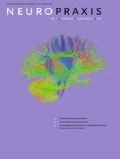Abstract
Schizofrenie is een ernstige en complexe psychiatrische ziekte waarvan de oorzaak nog onduidelijk is. De symptomen van deze ziekte zijn onder andere wanen, hallucinaties, spraakarmoede, anhedonie (gebrek aan plezier), sociale teruggetrokkenheid, bizar gedrag en denkstoornissen. Bij veel schizofreniepatiënten ontstaan in de adolescentie prodromale symptomen zoals beperkingen in het functioneren, ernstige tekortkomingen op het gebied van zelfverzorging en terugtrekking uit sociale contacten. Na de prodromale fase kan een actieve psychotische periode optreden waarin wanen en hallucinaties op de voorgrond staan. Tijdens een psychotische periode is er vaak sprake van agitatie en een gestoord realiteitsbesef. De patiënt kan zeer prikkelbaar zijn en bijvoorbeeld denken het slachtoffer te worden van een complot.






Literatuur
Bour, L.J., van Ginsbergen, J.A.M., Bruijns, J. en Ottes, F.P. (1984). The double magnetic induction method for measuring eye movements – results in monkey and man.ieee Trans Biomed Eng 31, 419-427.
Braff, D.L. (1993). Information processing and attention dysfunctions in schizophrenia. Schizophrenia Bulletin 19, 233-259.
Clementz, B.A. en Sweeney, J.A. (1990). Is eye movement dysfunction a biological marker for schizophrenia? A methodological review. Psychological Bulletin 108, 77-92.Farde, L., Gustavsson, J.P. en Jönsson, E. (1997) D2 dopamine receptors and personality traits. Nature 385, 580.
Judd, L.L., McAdams, L., Budnick, B.A. en Braff, D.L. (1992) Sensory gating deficits in schizophrenia: New results. American Journal of Psychiatry 149, 488-493.
Nieman, D.H., Ongerboer de Visser, B.W., Koelman, J.H.T.M., Hofman, W.F. en Linszen, D.H. (1998). The P3 event-related potential in young recent-onset schizophrenic patients. International Clinical Psychopharmacology 13 (suppl 1), 67-73.Pfefferbaum, A., Walton, T.R. en Ford, J.M. (1995). Event-related potentials in the study of psychiatric disorders. Archives of General Psychiatry 52, 559-563.
Souza, V.B.N., Muir, W.J., Walker, M.T., Glabus, M.F., Roxborough, H.M., Sharp, C.W., Dunan, J.R. en Blackwood, D.H.R. (1995) Auditory P300 Event-Related Potentials and neuropsychological performance in schizophrenia and bipolar affective disorder. Biological Psychiatry 37, 300-310.
Wood, A. (1998). Clinical experience with olanzapine, a new atypical antipsychotic. International Clinical Psychopharmacology 13 (suppl 1), 59-62.
Author information
Authors and Affiliations
Rights and permissions
About this article
Cite this article
Nieman, D., Linszen, D., Koelman, J. et al. Neurofysiologische en neuropsychologische correlaten van schizofrenie. NEPR 3, 93–97 (1999). https://doi.org/10.1007/BF03070959
Issue Date:
DOI: https://doi.org/10.1007/BF03070959

